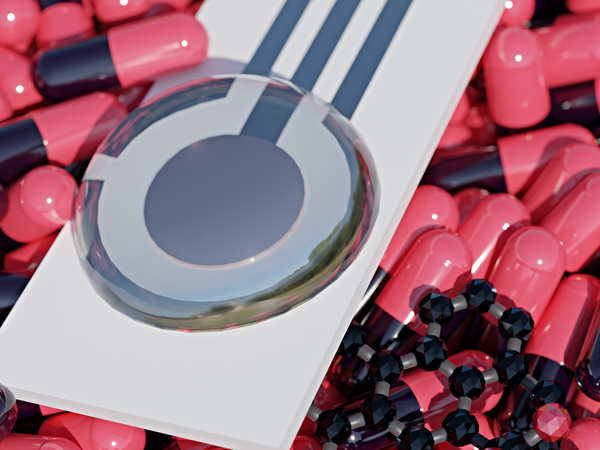A small box connected to a mobile phone—this is what the new biosensor looks like. This device can immediately detect even very small antibiotic residues, namely ampicillin, in water or dairy products. The basis forms a tailor-made nanomaterial derived from fluorographen, developed by scientists from the Czech Advanced Technology and Research Institute (CATRIN) of Palacký University and its Faculty of Science. They used the so-called click chemistry method, which was awarded the Nobel Prize in Chemistry last year. The development of the biosensor was introduced by the scientists in the journal Small.
“The increasing resistance of microorganisms to antibiotics is one of the most pressing problems in medicine today. There are estimates that it could be responsible for more deaths than cancer in 2050. In addition to new therapies, antibiotic levels in different samples also need to be closely monitored. Residual amounts of antibiotics have been shown to occur not only in wastewater, but also in drinking water or certain foods, which only enhances the ability of bacteria to develop resistance to them. We are therefore looking for fast, cheap, efficient and disposable electrochemical biosensors to prove the presence of antibiotics,” said research team leader Michal Otyepka from CATRIN.
The biosensor is composed of a new material derived from fluorographene that was tailor-made by Olomouc scientists. “Via alkyne groups bonded to graphene, we immobilized an aptamer—a molecule that is capable of detecting the antibiotic, i.e., ampicillin. We decided to use the method of the so-called click chemistry, which allows precise and fast binding of molecules. The uniqueness of this strategy lies not only in the procedure, but also in the possibility of connecting the sensor with a mobile phone. Such measurements can be made by anyone, for example in the home environment or directly in the field,” explained one of the authors David Panáček from CATRIN.
The effectiveness of the sensor was verified by researchers on tap water, in dairy products and in human saliva. They found that the biosensor can detect even lower amounts of drug residues in drinking water than the limit set by the European Union. The method is very simple—an electrode with the applied nanomaterial is immersed in a contaminated solution and the amount of ampicillin is measured by a mobile phone. So far the detection and further analyses have required expensive instruments and trained staff.
It’s not the first time CATRIN scientists have used graphene derivatives for biosensors. The idea to use them for antibiotic detection was introduced by José Flauzino shortly after his joining CATRIN. “As a biochemist, he had a very specific idea about the biosensor, but he needed a suitable material. We were able to tailor it in record time. Not more than a half a year has passed from the initial idea to the publication of the result,” explained material chemist Panáček. Another result of their collaboration in the past was a sensor for detecting the adulteration of beef by pork.
